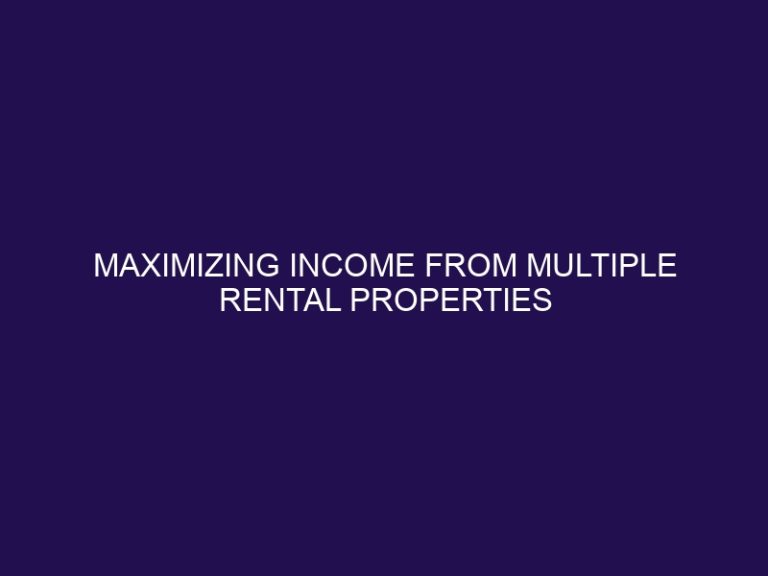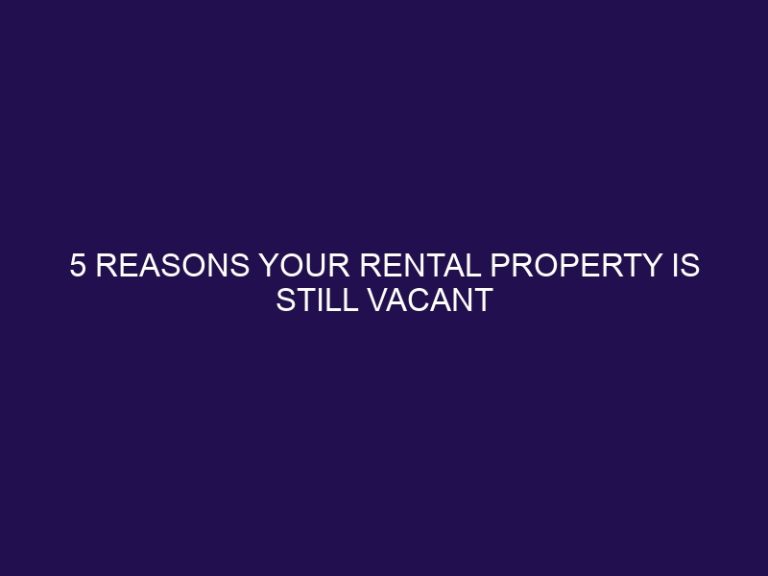Pros and Cons of Buying a Rental Home in a 55+ Community
A 55+ community, also known as an active adult community, is a residential neighborhood designed for individuals aged 55 and older. These communities often offer amenities and activities tailored to the needs and interests of older adults and provide a sense of community for its residents. Buying a rental home in a 55+ community can have its benefits and drawbacks, which should be carefully considered before making a decision.
There are several pros to buying a rental home in a 55+ community, such as:
- Age-Restricted Community: These communities have age restrictions in place, ensuring that residents are of a similar age and life stage.
- Amenities and Activities: Many 55+ communities offer amenities like golf courses, swimming pools, fitness centers, and organized activities, providing a convenient and enjoyable lifestyle for residents.
- Low Maintenance: Many rental homes in 55+ communities offer low maintenance living, with lawn care and home maintenance services included in the monthly fees.
- Sense of Community: Living in a 55+ community can provide a strong sense of community, with like-minded individuals and opportunities for socialization.
However, there are also cons to consider, including:
- Limited Options for Younger Residents: If you have family or friends under the age of 55, they may not be able to live with you in a 55+ community, limiting your options for potential renters.
- Potential for Higher Monthly Fees: Some 55+ communities may have higher monthly fees for amenities and services, which could impact your investment returns.
- Restrictions on Renting Out the Property: Some 55+ communities have restrictions on renting out the property, which could limit your ability to generate rental income.
- Potential for Age Discrimination: While age restrictions are in place for these communities, it could also lead to potential age discrimination issues.
Before buying a rental home in a 55+ community, it is essential to consider factors such as your age and future plans, the location and amenities of the community, the rules and regulations in place, and the long-term investment potential. Evaluating these factors can help you make an informed decision and ensure that a 55+ community is the right fit for your lifestyle and investment goals.
Key Takeaways:
What Is a 55+ Community?
A 55+ community is a specialized residential area created for individuals aged 55 and older. These communities provide specific amenities and social activities catered to the needs and preferences of older adults, promoting a strong sense of community and offering a supportive environment for aging residents.
What Are the Pros of Buying a Rental Home in a 55+ Community?
Are you considering purchasing a rental home in a 55+ community? This section will delve into the potential benefits of such a decision. From the perks of living in an age-restricted community to the various amenities and activities available, we will cover all the pros of buying a rental home in a 55+ community. Additionally, we will discuss the low maintenance lifestyle and strong sense of community that these communities often offer. Keep reading to discover the potential advantages of investing in a rental home in a 55+ community.
1. Age-Restricted Community
- Verify Age Restrictions: Make sure that the community has an age restriction of 55 or older, as is typical for age-restricted communities.
- Understand Community Guidelines: Familiarize yourself with the rules and regulations that govern age-restricted communities.
- Explore Amenities: Evaluate the amenities and activities that are designed to meet the specific needs of residents in a 55+ community.
2. Amenities and Activities
- Community Amenities: Explore various options such as fitness centers, golf courses, swimming pools, and social clubs.
- Recreational Activities: Participate in organized events like movie nights, group outings, and hobby classes.
- Social Gatherings: Engage in community potlucks, game nights, and holiday celebrations.
3. Low Maintenance
- Choose a home that requires minimal yard work and exterior maintenance.
- Explore properties that include lawn care and snow removal services.
- Search for communities that offer maintenance-free amenities such as pool and clubhouse upkeep.
4. Sense of Community
In a 55+ community, there is a strong sense of community that fosters friendships and a support system. Residents actively participate in social activities, group events, and shared interests, creating a vibrant and connected environment.
To further enhance this sense of community, consider joining community clubs, volunteering, or attending communal gatherings.
What Are the Cons of Buying a Rental Home in a 55+ Community?
While there are certainly many benefits to purchasing a rental home in a 55+ community, it’s important to also consider the potential downsides. In this section, we will discuss the cons of buying a rental home in a 55+ community, including limited options for younger residents and the potential for higher monthly fees. We will also touch on restrictions on renting out the property and the potential for age discrimination, so you can make an informed decision before investing in this type of property.
1. Limited Options for Younger Residents
- Explore alternative housing options in mixed-age communities.
- Consider communities with flexible age restrictions or intergenerational components.
- Consult with real estate agents who specialize in age-diverse housing.
- Research local housing laws and regulations to understand your options for younger residents.
Did you know? In the United States, approximately 1.8 million households are occupied by both grandparents and grandchildren under 18 years old.
2. Potential for Higher Monthly Fees
- Understand the fee structure: Scrutinize monthly fees, examining their components and the possibility of increases in the future.
- Review financial documents: Assess financial reports and projections to anticipate potential changes in fees.
- Consult current residents: Seek insights from residents regarding the history of fee increases and the level of transparency in management.
Considering these factors can assist you in making an informed decision about the potential for higher monthly fees.
3. Restrictions on Renting Out the Property
- Review community guidelines on renting out properties, including any restrictions that may be in place.
- Ensure that you understand any age or occupancy restrictions for renters.
- Check for any limitations on short-term rentals or Airbnb.
- It is also important to consult the community association for any additional rental policies or restrictions.
4. Potential for Age Discrimination
- Discrimination: Some 55+ communities may enforce age-related rules, potentially discriminating against younger individuals in housing options and social activities.
Pro-tip: Prioritize 55+ communities with inclusive policies to prevent potential age discrimination and foster a diverse and dynamic living environment.
What Are Some Things to Consider Before Buying a Rental Home in a 55+ Community?
As you consider purchasing a rental home in a 55+ community, it’s important to take a step back and think about the factors that will impact your decision. In this section, we will discuss some key elements to consider before making a purchase. From your age and future plans, to the location and amenities of the community, and even the rules and regulations that come with living in a 55+ community, each aspect plays a role in determining if this investment is the right choice for you. Let’s take a closer look at the pros and cons of buying a rental home in a 55+ community.
1. Your Age and Future Plans
- Evaluate your current age and consider potential lifestyle changes in the future with regards to your age and future plans.
2. Location and Amenities
When searching for a rental home in a 55+ community, it is important to consider the location and amenities offered. Look for communities that have easy access to medical facilities, recreational activities, and necessary services. Being close to family and friends also adds to the appeal of the location.
3. Rules and Regulations
- Age Restrictions: Make sure you understand the minimum age requirements set for residents.
- Property Use: Familiarize yourself with the regulations regarding renting out the property.
- Community Guidelines: Take the time to review and understand the specific rules and regulations set by the community association.
4. Long-Term Investment Potential
When considering long-term investment potential in a 55+ community, it is important to assess factors such as:
- property appreciation
- rental demand
- potential resale value
This includes evaluating the desirability of the location, growth trends of the community, and the financial stability of the community association. It is important to compare the potential for long-term returns to other investment options before making a decision.
Frequently Asked Questions
What are the pros and cons of buying a rental home in a 55+ community?
Buying a rental home in a 55+ community has its benefits and drawbacks. On one hand, there is a high demand for these communities from the aging Baby Boomer population. On the other hand, there may be limited investment properties and potential competition from other senior housing options. Additionally, there may be monthly fees associated with these communities. It is important to carefully evaluate these factors before making any investment decisions.
What are the upsides of investing in a 55+ community?
Investing in a 55+ community can offer a variety of advantages. There is often a high rental demand and potential for higher rent rates. The operating costs may also be lower due to the lack of meal services and healthier population. Additionally, these communities offer a mix of features that cater to the active lifestyle interests of the Baby Boomer generation.
What are the potential downsides of investing in a 55+ community?
While there are many benefits to investing in a 55+ community, there are also some potential downsides to consider. These include potential competition from other senior housing options, the need for careful management to maintain the active lifestyle appeal, and the possibility of limited investment properties in certain areas.
What should I know about the target market for 55+ communities?
The target market for 55+ communities is primarily Baby Boomers, who are seeking housing options tailored to their active lifestyles. This market is expected to continue growing in the coming years, making it a lucrative investment opportunity for landlords and property investors.
What are some important factors to consider when investing in a rental property in a 55+ community?
When considering investing in a rental property in a 55+ community, it is important to research the community location, amenities offered, and potential rental possibilities. It is also essential to understand the target market, potential competition, and any associated fees or costs.
What are some tips for successfully managing a rental property in a 55+ community?
To ensure success in managing a rental property in a 55+ community, it is important to understand the needs and preferences of this demographic. This may include incorporating age-friendly features in the design of the community, offering added amenities such as on-site security teams and health clubs, and having a targeted marketing plan to attract prospective residents.







